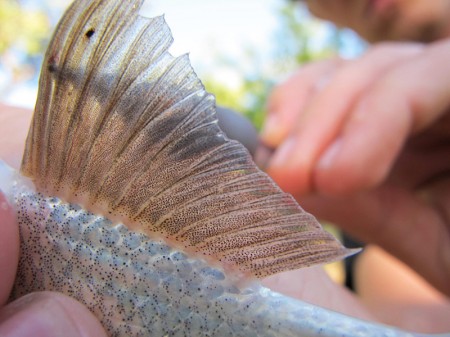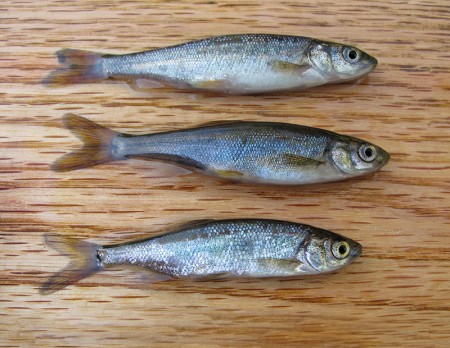Monday July 18, 2011
 The number of spines or rays in the dorsal fin of a fish is a key morphological feature used to differentiate similar species. Dorsal fins may have only soft rays, as in the photo above, or a combination of spines and rays. Spines are bony, rigid and sometimes sharp projections that provide structure and can be used for defense. Fish are not always easy to distinguish by body shape alone, such as the three different minnow species (Cyprinidae family) in the photo below, so biologists rely on fin spine and ray counts, and fin shape and position to differentiate species. Holding a live fish still while counting small rays and spines can be a challenge. With digital photography, we find that it is sometimes more convenient and less stressful for fish if we take a photo of the fin, and then zoom in on the camera’s LCD screen to count the rays and spines.
The number of spines or rays in the dorsal fin of a fish is a key morphological feature used to differentiate similar species. Dorsal fins may have only soft rays, as in the photo above, or a combination of spines and rays. Spines are bony, rigid and sometimes sharp projections that provide structure and can be used for defense. Fish are not always easy to distinguish by body shape alone, such as the three different minnow species (Cyprinidae family) in the photo below, so biologists rely on fin spine and ray counts, and fin shape and position to differentiate species. Holding a live fish still while counting small rays and spines can be a challenge. With digital photography, we find that it is sometimes more convenient and less stressful for fish if we take a photo of the fin, and then zoom in on the camera’s LCD screen to count the rays and spines.
So, have you guessed which species are in these photos? If you’ve been participating in our fish ID game on Facebook, the anal fin in the top photo belongs to a hitch (Lavinia exilicauda), which is also the bottom fish in the lower photo. It has more than 10 anal fin rays, while the other two fish in the lower photo have 8 or 9 anal fin rays. The fish on top is a Sacramento pikeminnow (Ptychocheilus grandis) and has a loosely attached frenum, whereas the middle fish is a Hardhead (Pogonichthys macrolepidotus) with a tightly attached frenum.

